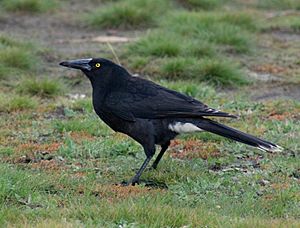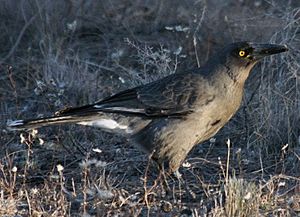Grey currawong facts for kids
Quick facts for kids Grey currawong |
|||
|---|---|---|---|
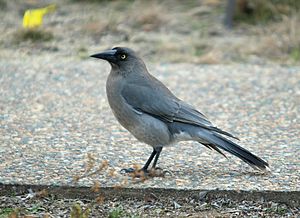 |
|||
| Subspecies versicolor, Canberra | |||
| Conservation status | |||
| Scientific classification | |||
| Genus: |
Strepera
|
||
| Species: |
versicolor
|
||
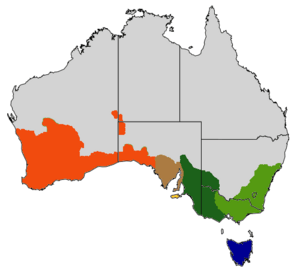 |
|||
| Grey currawong range subspecies indicated
|
|||
The grey currawong (Strepera versicolor) is a large bird found in southern Australia, including Tasmania. It is one of three currawong species. These birds are related to butcherbirds and the Australian magpie.
This crow-like bird is about 48 cm (19 in) long. It has bright yellow eyes and a strong bill. Its feathers are dark, but it has white patches under its tail and on its wings. Male and female currawongs look very similar.
There are six different types, or subspecies, of grey currawongs. Their feather colours range from slate-grey to very dark black. All grey currawongs are known for their loud, ringing calls.
Grey currawongs usually stay in one area. However, some move to southeastern Australia during winter. Scientists still have much to learn about their behaviour. They eat a mix of berries, insects, and small animals. Unlike the pied currawong, they spend more time looking for food on the ground. They build their nests high in trees, which makes them hard to study. Sadly, their numbers have gone down in many places. They live in forests and scrublands.
Contents
About the Grey Currawong
What's in a Name?
The grey currawong was first described in 1801 by a scientist named John Latham. He called it "variable crow." The scientific name versicolor means 'of variable colours' in Latin.
People used to call this bird by many other names. These include grey crow-shrike, mountain magpie, and clinking currawong. In Western Australia, some called it "squeaker." The Ramindjeri people called the black-winged currawong wati-eri, meaning "to sneak."
Currawongs and Their Relatives
The grey currawong belongs to a group of birds called Strepera. This group also includes the pied currawong and the black currawong. Even though they look like crows, currawongs are not closely related to true crows.
Instead, they are close relatives of the Australian magpie and the butcherbirds. Scientists grouped these birds together because they share similar features.
Different Types of Grey Currawongs
There are six main types, or subspecies, of grey currawongs across Australia. They look quite different from each other. Their feather colours range from grey to very dark black. The amount of white on their wings also varies.
- S. v. versicolor: This is the main type, called the grey currawong. It lives in New South Wales and Victoria.
- S. v. intermedia: This type is grey-brown and is called the brown currawong. It is found in South Australia. It is the smallest of the six subspecies.
- S. v. arguta: This is the darkest type. It lives in eastern Tasmania and is known as the clinking currawong because of its call. It is also called the black magpie.
- S. v. melanoptera: This type is called the black-winged currawong. It lives in western Victoria and South Australia. It has very dark, blackish-brown feathers and usually no white wing markings.
- S. v. halmaturina: This type lives only on Kangaroo Island. It has dark feathers and a longer, thinner bill.
- S. v. plumbea: This type is found in Western Australia and parts of South Australia. People sometimes call it "squeaker" because of its call. It looks similar to the main grey currawong but has a thicker, more curved bill.
What Does a Grey Currawong Look Like?
The grey currawong is a large bird, usually between 44 to 57 cm (17 to 22 in) long. Its wingspan is about 72 to 85 cm (28 to 33 in). On average, it weighs around 350 grams (12 oz). Tasmanian currawongs are a bit heavier, about 440 grams (16 oz). Males are slightly bigger than females.
These birds are generally dark grey. They have white patches on their wings, under their tail, and at the tip of their tail. Their eyes are yellow. Their legs, feet, and bill are black.
The exact colour of their feathers depends on the subspecies. Some are slate-grey, others are blackish-brown, and some are sooty black. The white patch on the wing also varies. It is large and easy to see on some types, but missing or hard to spot on others.
Young birds look a bit different. Their feathers are more brown and uniform. Their bill is black with a yellow tip, and their eyes are brownish before turning yellow. They change into adult feathers when they are about one year old.
What Sounds Do They Make?
The grey currawong's call is very different from its name. It is famous for a loud, ringing sound. People describe it as p'rink, clink, cling, or ker-link. They make this sound when flying or when many birds gather.
In Tasmania, their call sounds like a squeaky wheelbarrow. In Western Australia, it's like a harsh squeak. Sometimes, the superb lyrebird copies the currawong's call.
They also have a softer, more musical call, like a "toy-trumpet." Some say this call means rain is coming. Females and young birds make loud squawking sounds when they want food.
How to Tell Them Apart
It's easy to confuse grey currawongs with other currawongs. But they are different from crows and ravens. Crows and ravens are all black, have a stronger build, and white eyes. Grey currawongs have yellow eyes.
You might see grey currawongs with pied currawongs. Grey currawongs are paler and have different calls. The black-winged currawong looks darker, but it doesn't have the white wing patches of the pied currawong. In Tasmania, the black currawong is similar but has a heavier bill and no white on its rump.
Where Do Grey Currawongs Live?
Grey currawongs live across southern Australia. You can find them from the Central Coast of New South Wales, all the way west to Western Australia. The clinking currawong subspecies lives only in Tasmania. There is also a small group in the desert where the Northern Territory, South Australia, and Western Australia meet.
These birds usually stay in the same area all year. However, some move to warmer places during the colder months.
They live in many types of forests, from wet to dry. They also like mallee scrublands and open areas like parks or farms near forests. They can even be found in pine tree farms.
Sadly, the number of grey currawongs has gone down in many places. This is often because their homes are being destroyed. They used to be common but are now rare in some areas. In the Sydney Basin, they have always been uncommon. Their status in the Northern Territory is uncertain; they might even be gone from there.
Behaviour and Habits
Scientists don't know much about the social life of grey currawongs. They are generally shyer than their pied relatives. However, in some areas, they have gotten used to people.
They fly fast and silently, with an up-and-down motion. On the ground, they hop or run. You usually see them alone or in pairs. But they can gather in groups of up to eleven birds. If they find a fruit tree, as many as forty birds might gather to eat.
Grey currawongs sometimes chase away bigger birds like eagles. They have been seen bathing in water and even putting clay on their feathers.
Life Cycle
The breeding habits of the grey currawong are not well known. Their nests are hard to reach, which makes them difficult to study. They breed from August to December.
They build a large, shallow nest from thin sticks. They line it with grass and bark. These nests are usually high up in eucalypt trees. A female lays one to five eggs, but usually two or three.
The eggs vary in size and colour depending on the subspecies. They can be pale brown, buff, or even a faint wine colour. They have streaks or spots of darker brown, purple, or grey. The eggs of the clinking currawong are larger and paler.
It takes about 23 days for the eggs to hatch. Like all songbirds, the chicks are born naked and blind. They stay in the nest for a long time. Both parents help feed the young birds.
Most nests are successful, with at least one young bird leaving the nest. Sometimes, strong winds can destroy nests. Other currawongs, like pied currawongs, might also bother their nests.
What Do Grey Currawongs Eat?
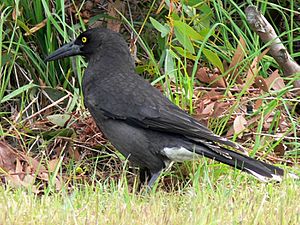
The grey currawong eats many different things. It is an omnivore, meaning it eats both plants and animals. They hunt snails, spiders, and many kinds of insects like beetles and grasshoppers. They also eat small animals such as frogs, lizards, rats, and mice. Sometimes, they eat the young birds from other nests.
They also eat a lot of plant material. This includes berries and fruits from many native Australian plants. They also eat fruits from plants brought from other countries, like pyracantha and cotoneaster berries. They enjoy farm crops too, such as corn, apples, pears, grapes, and tomatoes.
Grey currawongs usually look for food on the ground. Sometimes, they search in trees or bushes. They often poke their bills into the ground to find prey. They can also use their strong bills to pry open cracks in rocks or tree bark to find insects.
They usually swallow their food whole. One bird was seen sticking a rodent on a stick and eating parts of it, like a butcherbird. Grey currawongs can live near roads. However, they don't eat roadkill and often get hit by cars.
In Aboriginal Mythology
The grey currawong is part of an important Dreaming story for the Kaurna people. In this story, an ancestor hero named Tjilbruke kills a grey currawong. He uses its fat and feathers before he changes into a glossy ibis.
See also
 In Spanish: Verdugo cenizo para niños
In Spanish: Verdugo cenizo para niños



